Research Progress in Construction Workers’ Risk-Taking Behavior and Hotspot Analysis Based on CiteSpace Analysis
Abstract
1. Introduction
2. Data Sources and Methods of Analysis
2.1. Data Sources and Screening
2.2. Methods of Analysis
3. Analysis of the Current State of Research
3.1. Trends in the Number of Publications
3.2. Cooperation Network
4. Knowledge Base Analysis
4.1. Co-Citation Clustering
4.2. Frequently Cited Literature
5. Research Keywords Evolution
5.1. Co-Word Analysis
5.2. Evolution of Keywords
6. Conclusions and Future Prospects
Author Contributions
Funding
Data Availability Statement
Conflicts of Interest
Abbreviations
| EEG | electroencephalogram |
| fNIRS | functional near-infrared spectroscopy |
| VR | virtual reality |
| WSCC | The Web of Science Core Collection |
| IoT | The Internet of Things |
References
- Peng, Y.; Zhang, S.; Wu, P. Factors influencing workplace accident costs of building projects. Saf. Sci. 2015, 72, 97–104. [Google Scholar] [CrossRef]
- Guo, S.Y.; He, J.L.; Li, J.C.; Tang, B. Exploring the Impact of Unsafe Behaviors on Building Construction Accidents Using a Bayesian Network. Int. J. Environ. Res. Public Health 2020, 17, 221. [Google Scholar] [CrossRef]
- Yang, J.J.; Ye, G.; Xiang, Q.T.; Kim, M.; Liu, Q.J.; Yue, H.Z. Insights into the mechanism of construction workers’ unsafe behaviors from an individual perspective. Saf. Sci. 2021, 133, 105004. [Google Scholar] [CrossRef]
- Han, Y.; Li, X.Z.; Feng, Z.D.; Jin, R.Y.; Kangwa, J.; Ebohon, O.J. Grounded Theory and Social Psychology Approach to Investigating the Formation of Construction Workers’ Unsafe Behaviour. Comput. Intell. Neurosci. 2022, 2022, 581563. [Google Scholar] [CrossRef]
- Man, S.S.; Chan, A.H.S.; Alabdulkarim, S.; Zhang, T. The effect of personal and organizational factors on the risk-taking behavior of Hong Kong construction workers. Saf. Sci. 2021, 136, 105155. [Google Scholar] [CrossRef]
- Hasanzadeh, S.; de la Garza, J.M.; Geller, E.S. How Sensation-Seeking Propensity Determines Individuals’ Risk-Taking Behaviors: Implication of Risk Compensation in a Simulated Roofing Task. J. Manag. Eng. 2020, 36, 04020047. [Google Scholar] [CrossRef]
- Shuang, D.; Heng, L.; Skitmore, M.; Qin, Y. An experimental study of intrusion behaviors on construction sites: The role of age and gender. Saf. Sci. 2019, 115, 425–434. [Google Scholar] [CrossRef]
- Jeon, J.; Cai, H. Classification of construction hazard-related perceptions using: Wearable electroencephalogram and virtual reality. Autom. Constr. 2021, 132, 103975. [Google Scholar] [CrossRef]
- Fu, H.; Xia, Z.; Tan, Y.; Peng, Y.; Fan, C.; Guo, X. Fear Arousal Drives the Renewal of Active Avoidance of Hazards in Construction Sites: Evidence from an Animal Behavior Experiment in Mice. J. Constr. Eng. Manag. 2024, 150, 04024146. [Google Scholar] [CrossRef]
- Yu, W.D.; Wang, K.C.; Wu, H.T. Empirical Comparison of Learning Effectiveness of Immersive Virtual Reality-Based Safety Training for Novice and Experienced Construction Workers. J. Constr. Eng. Manag. 2022, 148, 04022078. [Google Scholar] [CrossRef]
- Shi, Y.; Du, J.; Ahn, C.R.; Ragan, E. Impact assessment of reinforced learning methods on construction workers’ fall risk behavior using virtual reality. Autom. Constr. 2019, 104, 197–214. [Google Scholar] [CrossRef]
- Wang, D.; Chen, J.; Zhao, D.; Dai, F.; Zheng, C.; Wu, X. Monitoring workers’ attention and vigilance in construction activities through a wireless and wearable electroencephalography system. Autom. Constr. 2017, 82, 122–137. [Google Scholar] [CrossRef]
- Wang, D.; Li, H.; Chen, J.Y. Detecting and measuring construction workers’ vigilance through hybrid kinematic-EEG signals. Autom. Constr. 2019, 100, 11–23. [Google Scholar] [CrossRef]
- Jeon, J.; Cai, H. Wearable EEG-based construction hazard identification in virtual and real environments: A comparative study. Saf. Sci. 2023, 165, 106213. [Google Scholar] [CrossRef]
- Akcay, C. Safety monitoring analysis in a construction site using eye-tracking method. Rev. De La Constr. 2022, 21, 602–617. [Google Scholar] [CrossRef]
- Muley, S.; Wang, C.; Aghazadeh, F. Personality traits affecting construction Worker’s near-miss recognition performance: Analysis based on eye tracking. Int. J. Ind. Ergon. 2024, 102, 103606. [Google Scholar] [CrossRef]
- Fu, H.; Tan, Y.; Xia, Z.; Feng, K.; Guo, X. Effects of construction workers’ safety knowledge on hazard-identification performance via eye-movement modeling examples training. Saf. Sci. 2024, 180, 106653. [Google Scholar] [CrossRef]
- Fu, H.; Xia, Z.; Tan, Y.; Guo, X. Influence of Cues on the Safety Hazard Recognition of Construction Workers during Safety Training: Evidence from an Eye-Tracking Experiment. J. Civ. Eng. Educ. 2024, 150, 04023009. [Google Scholar] [CrossRef]
- Chen, H.Y.; Mao, Y.H.; Xu, Y.D.; Wang, R. The Impact of Wearable Devices on the Construction Safety of Building Workers: A Systematic Review. Sustainability 2023, 15, 11165. [Google Scholar] [CrossRef]
- Adami, P.; Rodrigues, P.B.; Woods, P.J.; Becerik-Gerber, B.; Soibelman, L.; Copur-Gencturk, Y.; Lucas, G. Effectiveness of VR-based training on improving construction workers’ knowledge, skills, and safety behavior in robotic teleoperation. Adv. Eng. Inform. 2021, 50, 101431. [Google Scholar] [CrossRef]
- Ding, Z.K.; Xiong, Z.Y.; Ouyang, Y.W. A Bibliometric Analysis of Neuroscience Tools Use in Construction Health and Safety Management. Sensors 2023, 23, 9522. [Google Scholar] [CrossRef] [PubMed]
- Ke, J.J.; Zhang, M.; Luo, X.W.; Chen, J.Y. Monitoring distraction of construction workers caused by noise using a wearable Electroencephalography (EEG) device. Autom. Constr. 2021, 125, 103598. [Google Scholar] [CrossRef]
- Jeelani, I.; Han, K.; Albert, A. Automating and scaling personalized safety training using eye-tracking data. Autom. Constr. 2018, 93, 63–77. [Google Scholar] [CrossRef]
- Xiang, Q.T.; Liu, Y.; Goh, Y.M.; Ye, G.; Safiena, S. Investigating the Impact of Hazard Perception Failure on Construction Workers’ Unsafe Behavior: An Eye-Tracking and Thinking-Aloud Approach. J. Constr. Eng. Manag. 2024, 150, 04024066. [Google Scholar] [CrossRef]
- Hussain, R.; Zaidi, S.F.A.; Pedro, A.; Lee, H.J.; Park, C. Exploring construction workers’ attention and awareness in diverse virtual hazard scenarios to prevent struck-by accidents. Saf. Sci. 2024, 175, 106526. [Google Scholar] [CrossRef]
- Yoo, J.W.; Park, J.S.; Park, H.J. Understanding VR-Based Construction Safety Training Effectiveness: The Role of Telepresence, Risk Perception, and Training Satisfaction. Appl. Sci. 2023, 13, 1135. [Google Scholar] [CrossRef]
- Guo, X.; Liu, Y.; Tan, Y.; Xia, Z.; Fu, H. Hazard identification performance comparison between virtual reality and traditional construction safety training modes for different learning style individuals. Saf. Sci. 2024, 180, 106644. [Google Scholar] [CrossRef]
- Habibnezhad, M.; Puckett, J.; Jebelli, H.; Karji, A.; Fardhosseini, M.S.; Asadi, S. Neurophysiological testing for assessing construction workers’ task performance at virtual height. Autom. Constr. 2020, 113, 103143. [Google Scholar] [CrossRef]
- Alruqi, W.M.; Hallowell, M.R.; Techera, U. Safety climate dimensions and their relationship to construction safety performance: A meta-analytic review. Saf. Sci. 2018, 109, 165–173. [Google Scholar] [CrossRef]
- Man, S.S.; Chan, A.H.S.; Wong, H.M. Risk-taking behaviors of Hong Kong construction workers—A thematic study. Saf. Sci. 2017, 98, 25–36. [Google Scholar] [CrossRef]
- Rodríguez-Garzón, I.; Lucas-Ruiz, V.; Martínez-Fiestas, M.; Delgado-Padial, A. Association between Perceived Risk and Training in the Construction Industry. J. Constr. Eng. Manag. 2015, 141, 04014095. [Google Scholar] [CrossRef]
- Loosemore, M.; Malouf, N. Safety training and positive safety attitude formation in the Australian construction industry. Saf. Sci. 2019, 113, 233–243. [Google Scholar] [CrossRef]
- Pandit, B.; Albert, A.; Patil, Y.; Al-Bayati, A.J. Impact of safety climate on hazard recognition and safety risk perception. Saf. Sci. 2019, 113, 44–53. [Google Scholar] [CrossRef]
- He, C.; McCabe, B.; Jia, G.; Sun, J. Effects of Safety Climate and Safety Behavior on Safety Outcomes between Supervisors and Construction Workers. J. Constr. Eng. Manag. 2020, 146, 04019092. [Google Scholar] [CrossRef]
- Ma, H.; Wu, Z.G.; Chang, P. Social impacts on hazard perception of construction workers: A system dynamics model analysis. Saf. Sci. 2021, 138, 105240. [Google Scholar] [CrossRef]
- Malakoutikhah, M.; Alimohammadlou, M.; Jahangiri, M.; Rabiei, H.; Faghihi, S.A.; Kamalinia, M. Modeling the factors affecting unsafe behaviors using the fuzzy best-worst method and fuzzy cognitive map. Appl. Soft Comput. 2022, 114, 108119. [Google Scholar] [CrossRef]
- Seo, H.C.; Lee, Y.S.; Kim, J.J.; Jee, N.Y. Analyzing safety behaviors of temporary construction workers using structural equation modeling. Saf. Sci. 2015, 77, 160–168. [Google Scholar] [CrossRef]
- Shi, J.; Sun, Y.; Su, H.; Wang, Y.; Huang, Z.; Gao, L. Risk-taking behavior of drilling workers: A study based on the structural equation model. Int. J. Ind. Ergon. 2021, 86, 103219. [Google Scholar] [CrossRef]
- Guo, B.H.W.; Yiu, T.W.; Gonzalez, V.A. Predicting safety behavior in the construction industry: Development and test of an integrative model. Saf. Sci. 2016, 84, 1–11. [Google Scholar] [CrossRef]
- Newaz, M.T.; Davis, P.; Jefferies, M.; Pillay, M. The psychological contract: A missing link between safety climate and safety behaviour on construction sites. Saf. Sci. 2019, 112, 9–17. [Google Scholar] [CrossRef]
- Wu, X.; Li, Y.L.; Yao, Y.Z.; Luo, X.W.; He, X.H.; Yin, W.W. Development of Construction Workers Job Stress Scale to Study and the Relationship between Job Stress and Safety Behavior: An Empirical Study in Beijing. Int. J. Environ. Res. Public Health 2018, 15, 2409. [Google Scholar] [CrossRef]
- Gao, Y.F.; González, V.A.; Yiu, T.W.; Cabrera-Guerrero, G.; Deng, R.Q. Predicting Construction Workers’ Intentions to Engage in Unsafe Behaviours Using Machine Learning Algorithms and Taxonomy of Personality. Buildings 2022, 12, 841. [Google Scholar] [CrossRef]
- Gao, Y.F.; González, V.A.; Yiu, T.W.; Cabrera-Guerrero, G.; Li, N.; Baghouz, A.; Rahouti, A. Immersive virtual reality as an empirical research tool: Exploring the capability of a machine learning model for predicting construction workers’ safety behaviour. Virtual Real. 2022, 26, 361–383. [Google Scholar] [CrossRef]
- Namian, M.; Albert, A.; Feng, J. Effect of Distraction on Hazard Recognition and Safety Risk Perception. J. Constr. Eng. Manag. 2018, 144, 04018008. [Google Scholar] [CrossRef]
- Solomon, T.; Esmaeili, B. Examining the Relationship between Mindfulness, Personality, and National Culture for Construction Safety. Int. J. Environ. Res. Public Health 2021, 18, 4998. [Google Scholar] [CrossRef]
- Yi, W.; Chan, A. Health Profile of Construction Workers in Hong Kong. Int. J. Environ. Res. Public Health 2016, 13, 1232. [Google Scholar] [CrossRef]
- Liu, Y.; Ye, G.; Xiang, Q.T.; Yang, J.J.; Goh, Y.M.; Gan, L. Antecedents of construction workers’ safety cognition: A systematic review. Saf. Sci. 2023, 157, 105923. [Google Scholar] [CrossRef]
- Li, H.; Wang, D.; Chen, J.Y.; Luo, X.C.; Li, J.; Xing, X.J. Pre-service fatigue screening for construction workers through wearable EEG-based signal spectral analysis. Autom. Constr. 2019, 106, 102851. [Google Scholar] [CrossRef]
- Gómez-Salgado, C.; Camacho-Vega, J.C.; Gómez-Salgado, J.; García-Iglesias, J.J.; Fagundo-Rivera, J.; Allande-Cussó, R.; Martín-Pereira, J.; Ruiz-Frutos, C. Stress, fear, and anxiety among construction workers: A systematic review. Front. Public Health 2023, 11, 1226914. [Google Scholar] [CrossRef] [PubMed]
- Kim, S.; Lee, H.; Hwang, S.; Yi, J.S.; Son, J. Construction workers’ awareness of safety information depending on physical and mental load. J. Asian Archit. Build. Eng. 2022, 21, 1067–1077. [Google Scholar] [CrossRef]
- Pooladvand, S.; Hasanzadeh, S. Impacts of Stress on Workers’ Risk-Taking Behaviors: Cognitive Tunneling and Impaired Selective Attention. J. Constr. Eng. Manag. 2023, 149, 04023060. [Google Scholar] [CrossRef]
- Deng, S.W.; Peng, R.; Pan, Y.G. A Cognitive Failure Model of Construction Workers’ Unsafe Behavior. Adv. Civ. Eng. 2022, 2022, 576600. [Google Scholar] [CrossRef]
- Gao, Y.F.; González, V.A.; Yiu, T.W. Exploring the Relationship between Construction Workers’ Personality Traits and Safety Behavior. J. Constr. Eng. Manag. 2020, 146, 04019111. [Google Scholar] [CrossRef]
- Bauer, A.; Beissert, S.; Knuschke, P. Prevention of occupational solar UV radiation-induced epithelial skin cancer. Hautarzt 2015, 66, 173–178. [Google Scholar] [CrossRef]
- Cherrie, J.W.; Nioi, A.; Wendelboe-Nelson, C.; Cowan, S.; Cherrie, M.; Rashid, S.; Cowie, H.; Ritchie, P.; Lansdown, T.C. Exposure to Solar UV During Outdoor Construction Work in Britain. Ann. Work. Expo. Health 2021, 65, 176–182. [Google Scholar] [CrossRef]
- Keurentjes, A.J.; Kezic, S.; Rustemeyer, T.; Hulshof, C.T.J.; van der Molen, H.F. Protection Against Solar Ultraviolet Radiation in Outdoor Construction Workers: Study Protocol for a Non-randomized Controlled Intervention Study. Front. Public Health 2021, 9, 602933. [Google Scholar] [CrossRef]
- Li, J.H.; Zhong, M.S.; Jiang, L.; Zhang, W.Y.; Ma, L. Assessing and mitigating health risks of workers exposed to volatile organic compounds in contaminated soils during active pit excavation: Accounting for exposure variability and uncertainty. J. Clean. Prod. 2024, 469, 143227. [Google Scholar] [CrossRef]
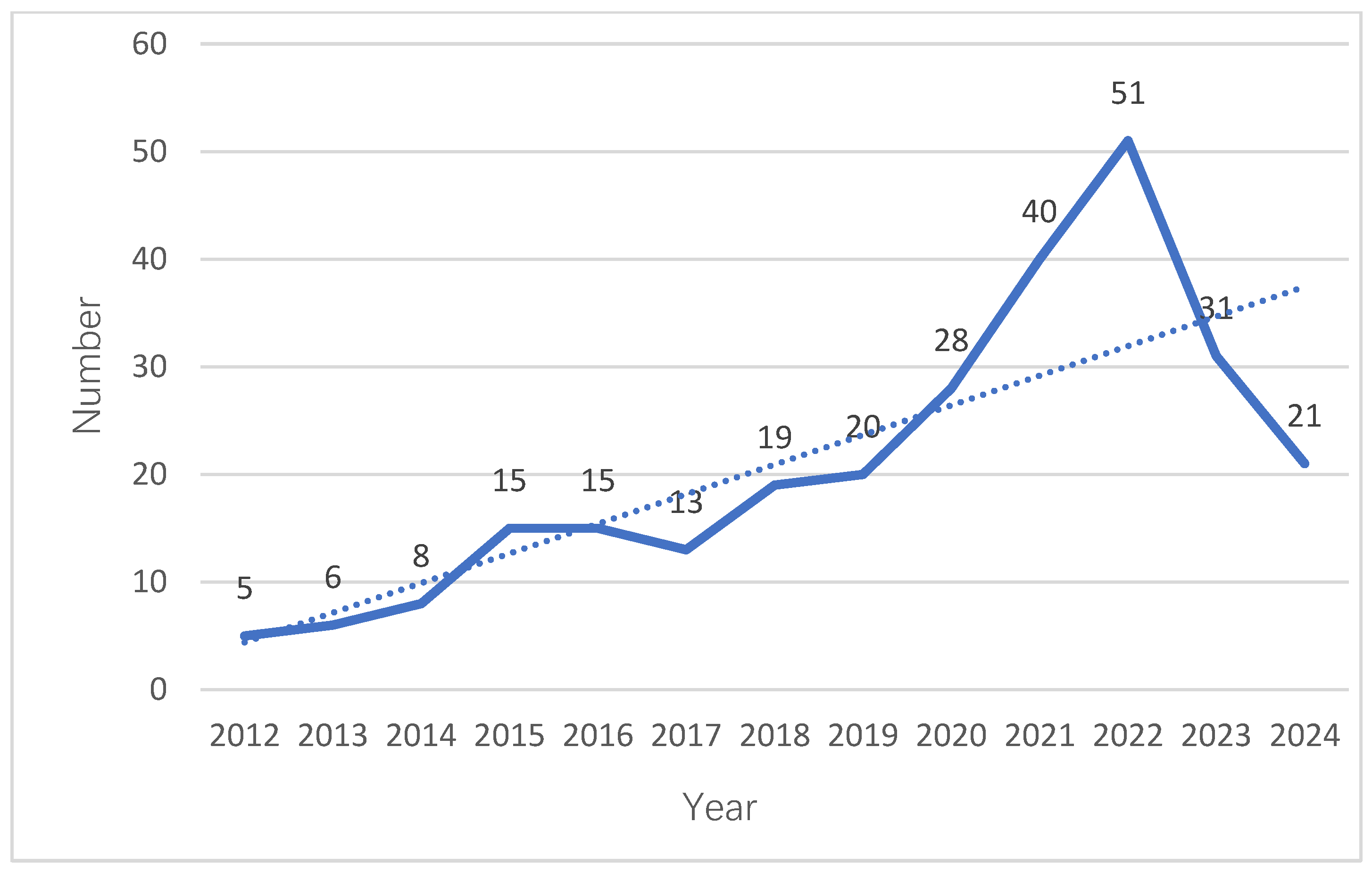
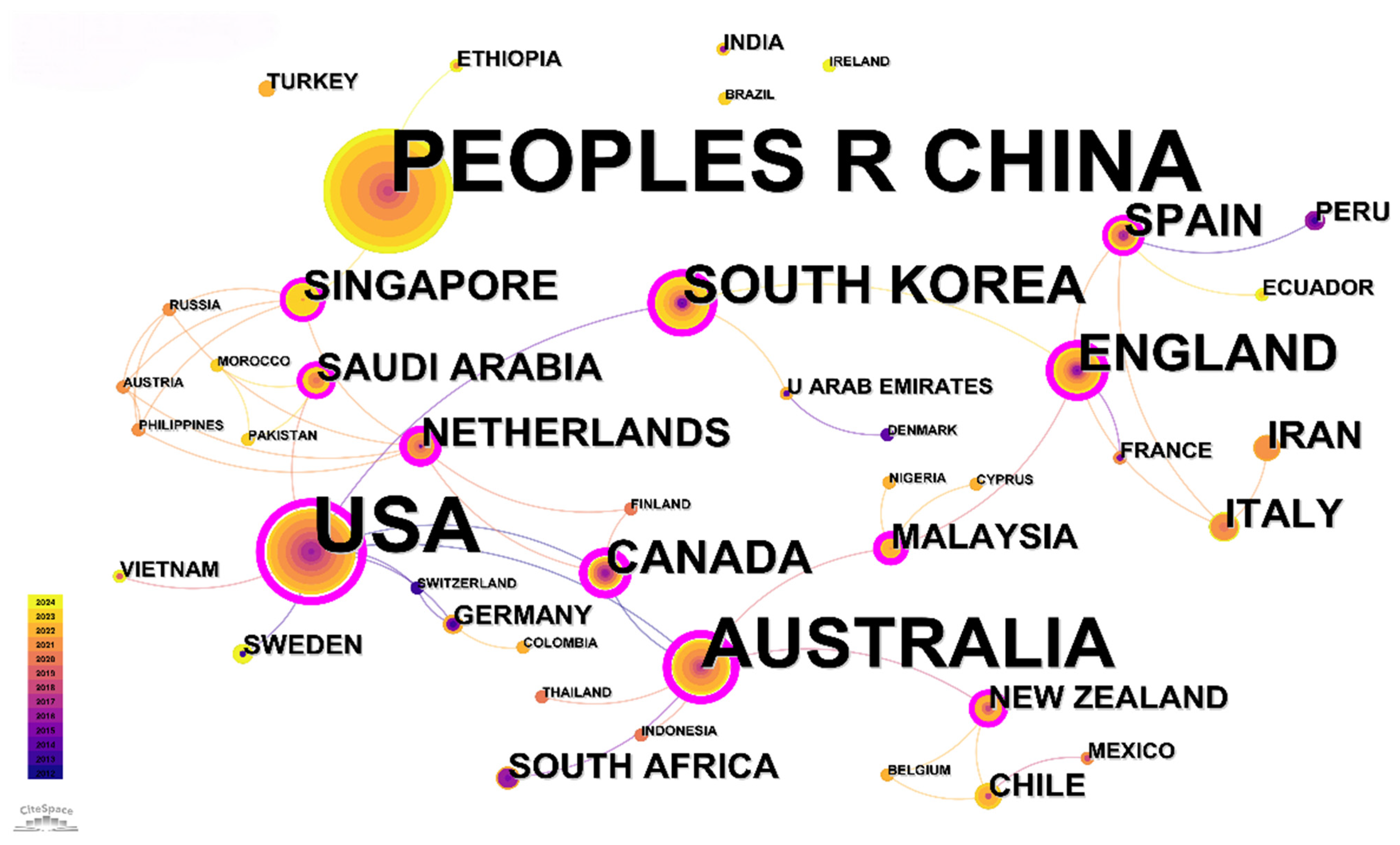

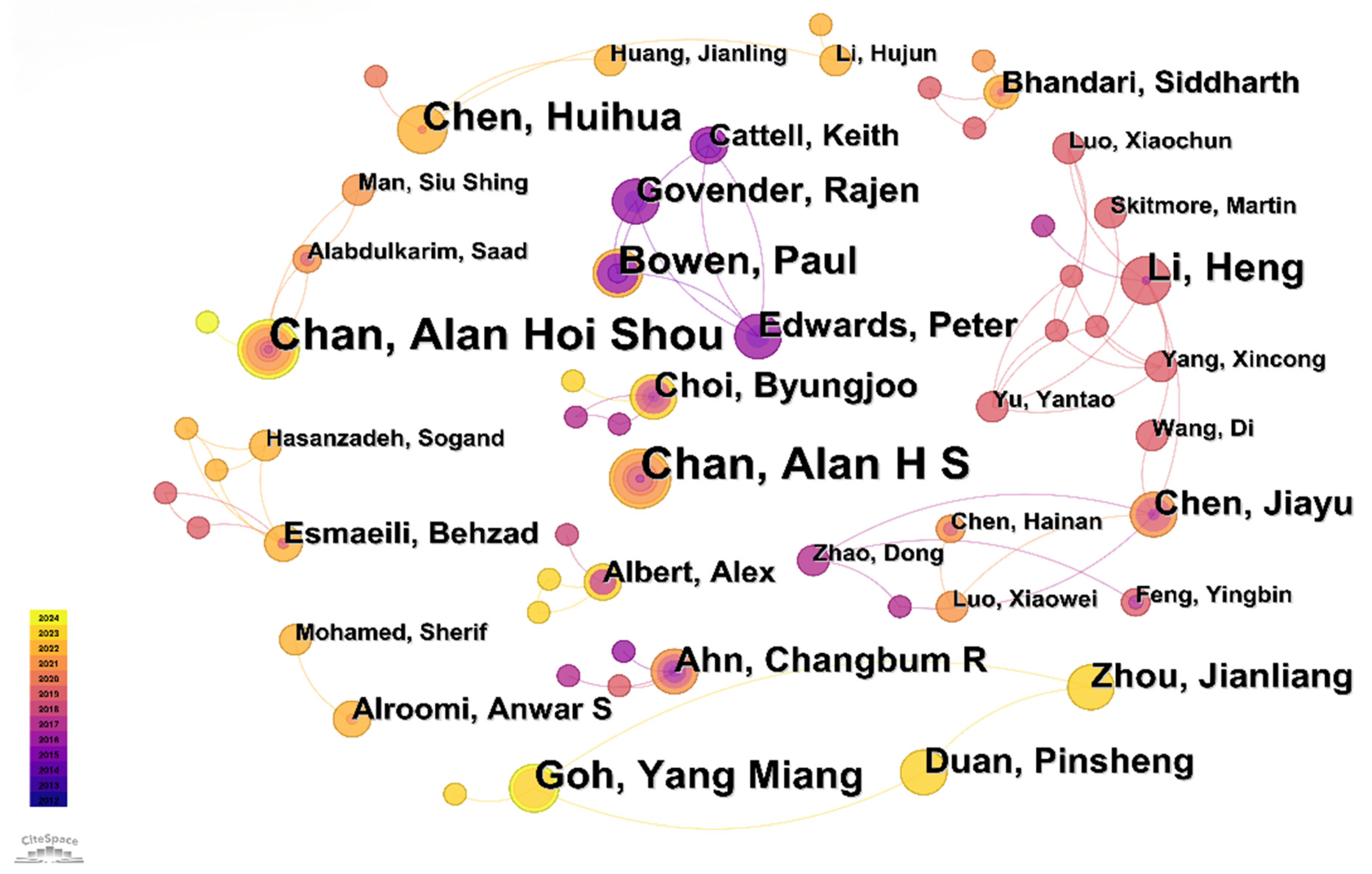
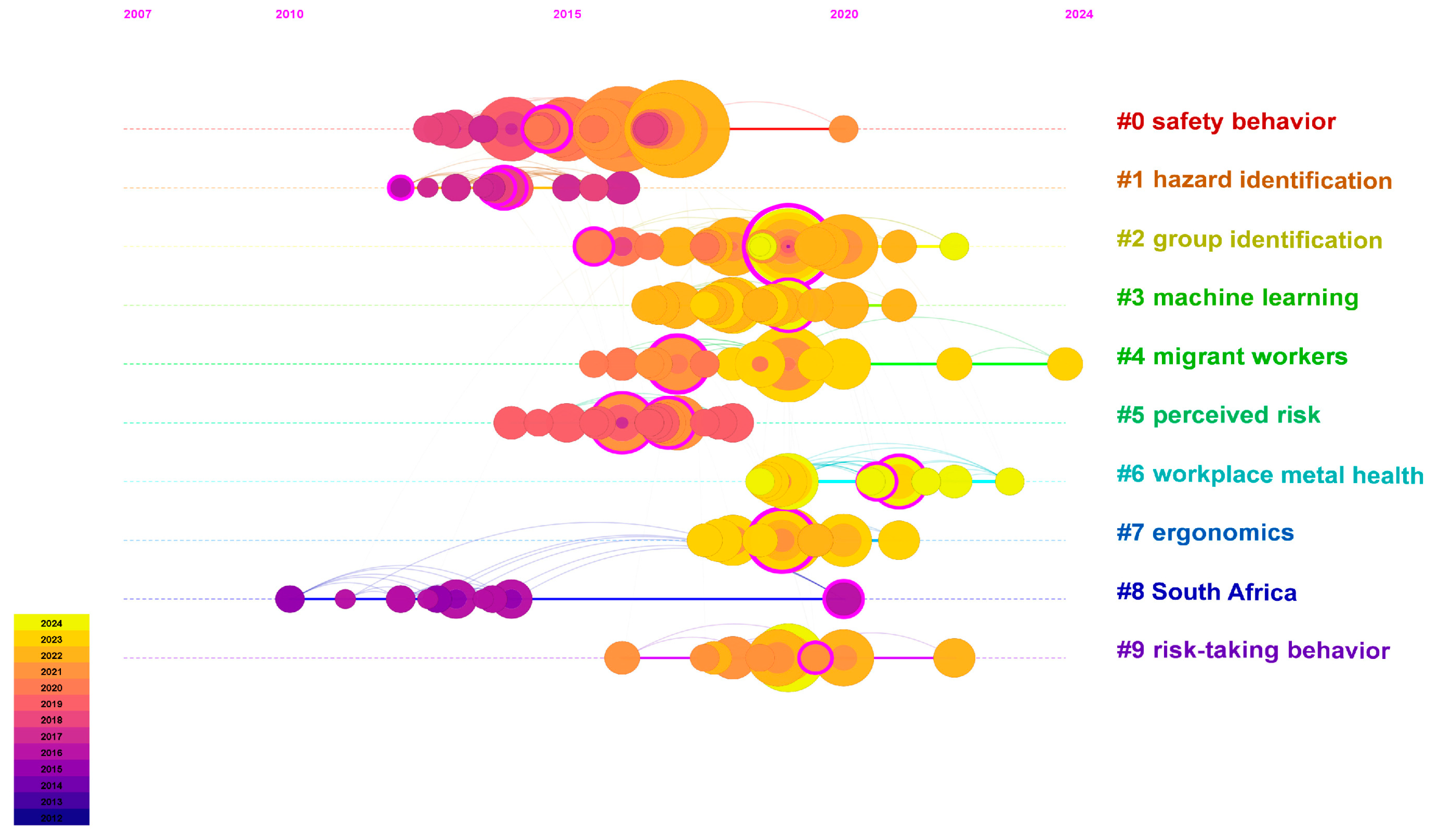
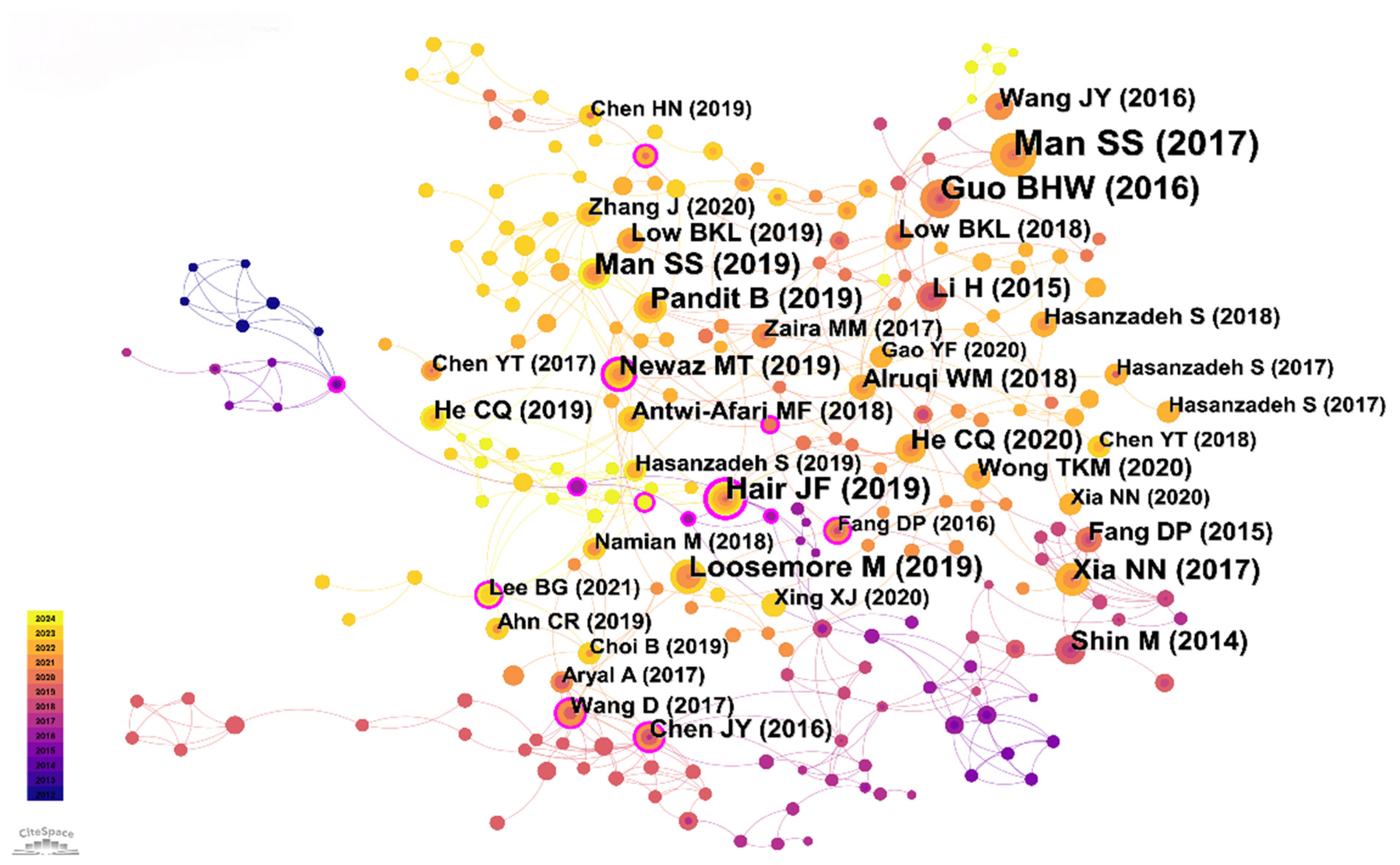


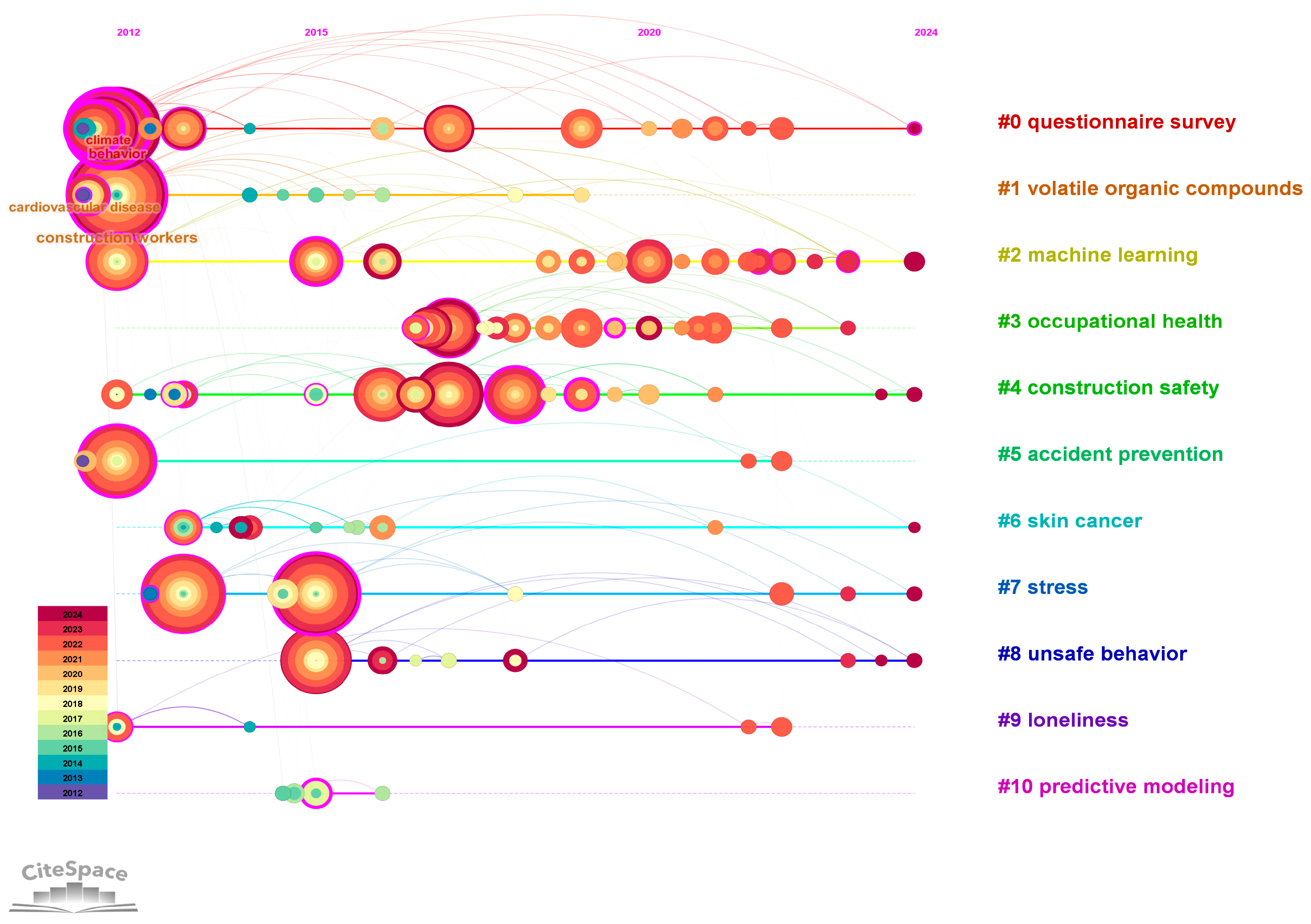
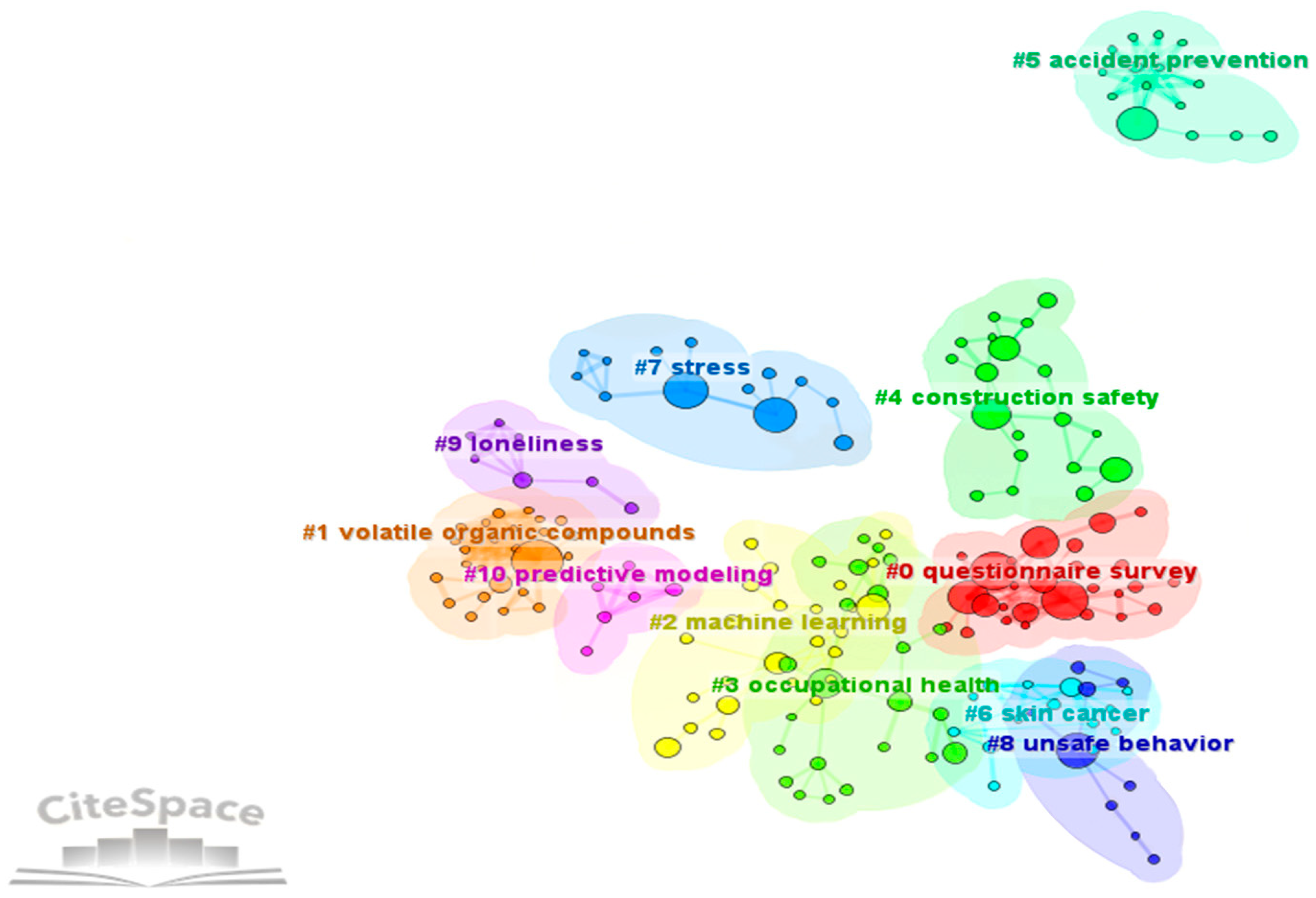
Disclaimer/Publisher’s Note: The statements, opinions and data contained in all publications are solely those of the individual author(s) and contributor(s) and not of MDPI and/or the editor(s). MDPI and/or the editor(s) disclaim responsibility for any injury to people or property resulting from any ideas, methods, instructions or products referred to in the content. |
© 2024 by the authors. Licensee MDPI, Basel, Switzerland. This article is an open access article distributed under the terms and conditions of the Creative Commons Attribution (CC BY) license (https://creativecommons.org/licenses/by/4.0/).
Share and Cite
Luo, Q.; Wang, S.; Huang, J.; Chen, H. Research Progress in Construction Workers’ Risk-Taking Behavior and Hotspot Analysis Based on CiteSpace Analysis. Buildings 2024, 14, 3786. https://doi.org/10.3390/buildings14123786
Luo Q, Wang S, Huang J, Chen H. Research Progress in Construction Workers’ Risk-Taking Behavior and Hotspot Analysis Based on CiteSpace Analysis. Buildings. 2024; 14(12):3786. https://doi.org/10.3390/buildings14123786
Chicago/Turabian StyleLuo, Qi, Sihan Wang, Jianling Huang, and Huihua Chen. 2024. "Research Progress in Construction Workers’ Risk-Taking Behavior and Hotspot Analysis Based on CiteSpace Analysis" Buildings 14, no. 12: 3786. https://doi.org/10.3390/buildings14123786
APA StyleLuo, Q., Wang, S., Huang, J., & Chen, H. (2024). Research Progress in Construction Workers’ Risk-Taking Behavior and Hotspot Analysis Based on CiteSpace Analysis. Buildings, 14(12), 3786. https://doi.org/10.3390/buildings14123786






